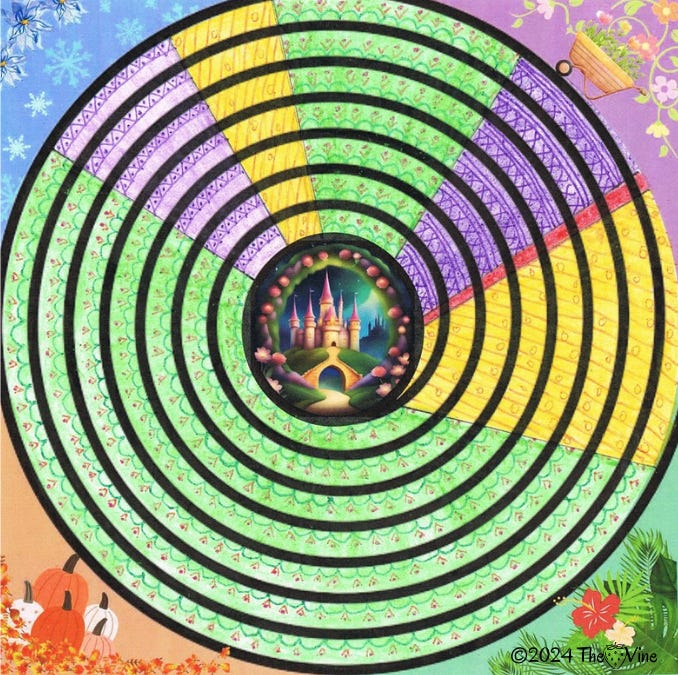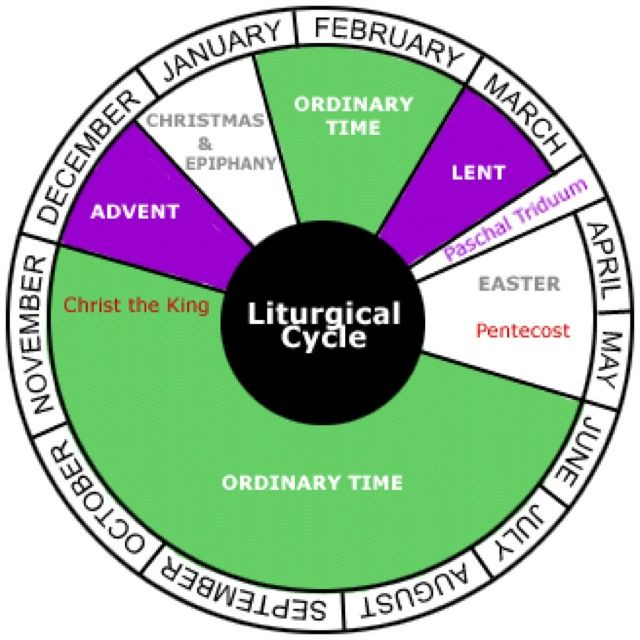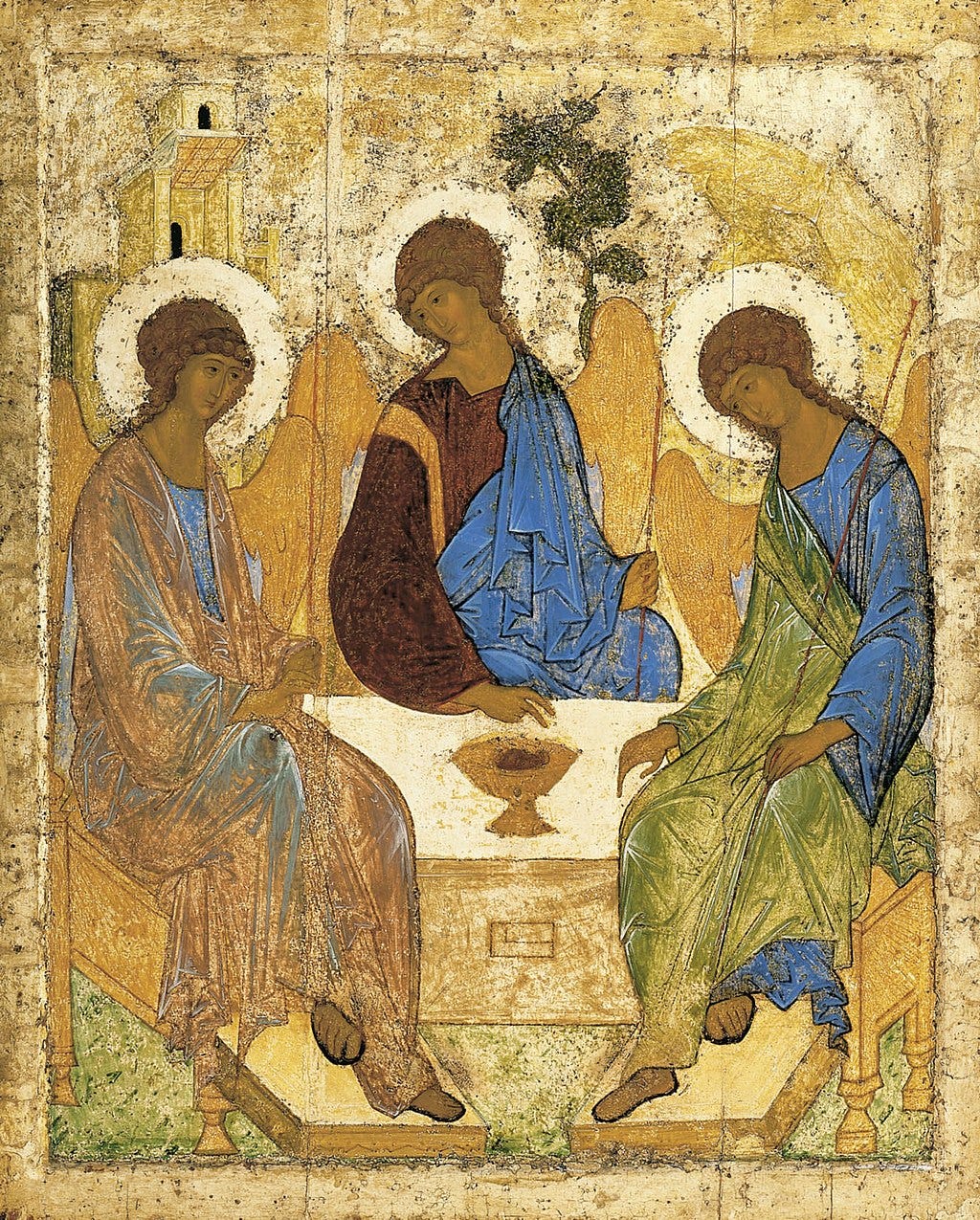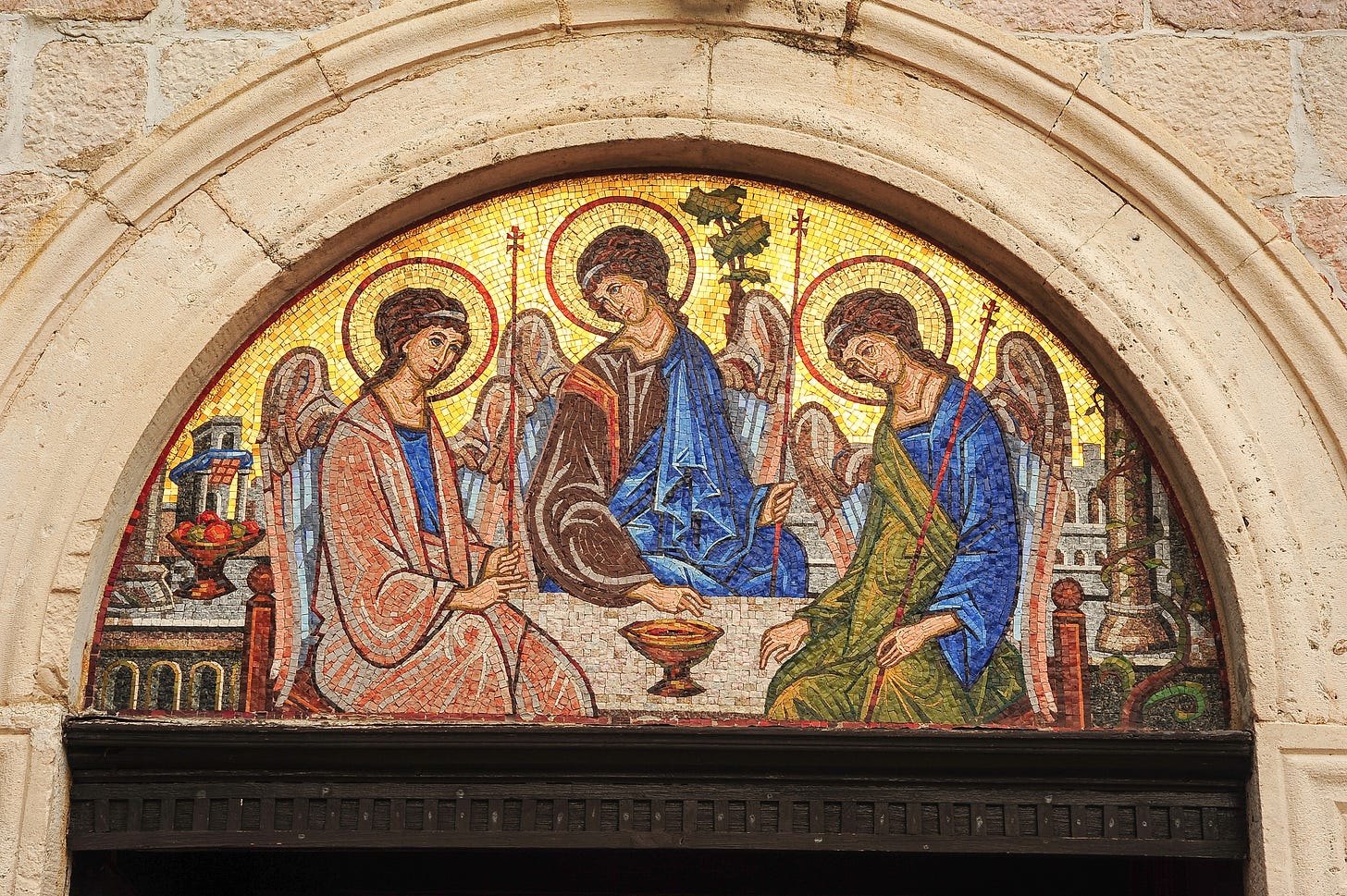“All the way to heaven is heaven, because Jesus said, "I am the way.” - St. Catherine of Siena
The idea of The Path has been on my mind a lot this month, which is why I chose it as the September Symbol. I suppose I’m thinking about paths because it’s the start of the new school year and classes have resumed once again. We’ve all started off on the journey through another academic and religious education year. School buses are rolling through the neighborhoods. The drop off and pick up lines are building and falling every morning and afternoon. Children are back in the parish hall for RE classes, or maybe slinging on their backpacks for the slog across a college campus to Bio 101 or English Lit.
But even if you’re not a student per se this year, the signs of journeys beginning are around everywhere. Movement and activities are taking place this month that were simply not there last month.
Although the fall makes journeying more apparent, if we think about it, we are on multiple journeys at every moment. For example, we travel through many different paths in time, at the same time. There’s the 24-hour journey, when we wake from sleep, rise to go about our daily tasks, and then fall back into bed each night.
We travel through the seven days of the week, over and over, without much thought. Sunday, Monday, Tuesday, Wednesday, Thursday, Friday, Saturday. Repeat.
Those weeks quickly add up into months. Every four months becomes a new season. Winter, spring, summer, fall. Those four seasons suddenly add up to an entire year. Years turn into decades.
Then there are journeys that move us through space, where we physically move from one place to another, like from home to work in the daily commute, or home to school and back again. Road trips, plane trips, train trips. We experience all kinds of journeys that move us physically.
Another place where we journey is within our bodies. Babies become toddlers, then children, teens and adults. Girls might become mothers, and boys can grow into fathers, as our bodies grow and develop and our capacity changes.
The new becomes old. Empires and entire civilizations rise and fall and are covered over by nature and assigned to history books. We are all on multiple journeys, moving down many paths, all the time and at the same time.
With all this movement, the question arises: Where exactly are we journeying to? What’s all this constant and continual activity for? What’s the point?
Different people will provide various answers, saying that the end goal of the journey is power, fame and great wealth. Perhaps others will say we journey for learning and knowledge. But the deeper answer is the same for everyone. We are all invited on a journey that will ultimately end, we hope, in the house of the Father. To get to this house, we have to walk the path of Continuing Conversion, and the easiest way to do that is by following that great spiritual path of the church year, more commonly known as the Liturgical Calendar. 1
The Liturgical Calendar unites our own passages through time and space, right now and right here, while also connecting past, present and future. As we journey through the year, the Liturgical Calendar divides our time into days of preparation, days of feasting, and all the days in between. It guides us through the feast days of the saints and martyrs and makes present once again God’s saving actions, through the daily offering of the Mass as well as through our annual reliving of Christ’s earthly mission. But most importantly, the Liturgical Calendar allows us to see that there is not, in fact, a strict division between the spiritual life we believe in through faith and the physical world that we see and encounter, even if there is certainly a strongly held belief that this division exists.
The Liturgical Calendar is the road home to the house of the Father because it centers around the life of Christ, who is “the way and the truth and the life.” No one comes to the Father except through him. (John 14:6)
Another way to picture the Liturgical Calendar is by moving from the more abstract time-based calendar to “reading” an icon, and one icon in particular speaks volumes about the pathway home. Painted by Russian artist Andrei Rublev in the early 15th century, the famous painting, known simply as the Holy Trinity Icon, portrays the unity of both the physical and the spiritual. The icon begins by representing the Old Testament story of Abraham receiving three guests by the oak of Mamre, told in Genesis 18. When Abraham first sees the three men, he does not realize they who they are. Nevertheless, he immediately runs towards them to offer hospitality, bringing them water, milk, bread, meat. He waits on them and attends to them, helping them to rest and recover.
Once the bodily, physically needs of the three have been met, they all begin to talk. It is through this conversation that Abraham’s eyes are opened, and he realizes with whom he is speaking. Abraham understands he is speaking with either God himself, or three angelic messengers who speak for God and are fully united to God.2 (In the end, there’s really not much difference.)
For easier viewing, here’s the same basic icon repeated in a mosaic above the door of a church in Budva, Montenegro. It literally invites us in to participate in the life of the Trinity by crossing the threshold below.
Rublev portrays the three beings as the Holy Trinity, giving each person unique clothing and a specific symbol that tells us who they are. God the Father is seated on the left, dressed in an ethereal, light changing garment. No one has seen the Father, but his image fills the universe. Over his shoulder is a house of gold, heaven, the home we are all seeking. The door to the house is always open, as is the window of the tower, so that the Father can constantly scan the road and come running for his prodigal child. God the Son is seated in the center. He is dressed in an earthy brown garment, covered by a heavenly blue cloak. These two items show that Christ unites heaven and earth, the divine and the human, in his person. Behind his shoulder is a tree, representing that life comes through him. He changes the tree of death to the tree of life, providing protection, shade and rest. Finally, God the Holy Spirit is seated on the right. He is dressed in the blue of the sky and the green of the grass, signifying the spirit of creation and re-creation moving across heaven and earth. In Rublev’s icon, a large mountain is portrayed behind him, reminding us that it is through the assistance of the Holy Spirit that we can follow Christ and journey up the difficult path of discipleship. This is the path home to the Father’s house.
But even though the three persons are seated, they are also being active. God the Son is bowing his head, in ascent to God the Father, while he points to the chalice on the table. In this image, Jesus is showing his willingness to do the will of his Father for all eternity, because his “food is to do the will of the one who sent me and to finish his work.” (John 4:34) God the Father looks across at God the Holy Spirit, while raising his hand in blessing to the Son. “The hand of the Son points on, around the circle, to the Spirit. In this simple array we see the movement of life towards us. The Father sends the Son, the Son sends the Spirit. The life flows clockwise around the circle.”3
But there is an open space in the icon, right where we are, at the point we are looking in. We are invited in to complete the circle, to participate in the life of the Holy Trinity. “As the Father sends the Son, as the Son sends the Holy Spirit, so we are invited and sent to complete the circle of the Godhead with our response. We respond to the movement of the Spirit who points us to Jesus. Jesus shows us the Father in whom all things come to fruition. This is the counter-clockwise movement of our lives, in response to the movement of God.”4 The circle repeats, going round and round, just like the Liturgical Calendar, inviting us in.
The icon also shows each of the persons of the Holy Trinity with a staff. Why would three beings with powerful wings need staffs? Because the staffs show how closely God walks with us. We are each on a journey and these three persons go with us, on our “slow movement across the face of the earth. God is with us in the weariness of our human road. The traveler God sits down at our ordinary tables and spreads them with a hint of heaven.”5
We are each, personally and corporally, invited in to complete the circle, to take our place in the dance and move along with God through our own response, in our time, in our lives, right here and right now.
A few weeks ago, I sat down at my computer and asked one of the design software programs to create a fairy-tale type of picture, something I could use on this Substack to talk about stories.6 Imagine my surprise when the castle above (in the center of the liturgical calendar) popped up, and I saw the second castle behind it, in the shadows on the hill. I immediately remembered Rublev’s icon of the Holy Trinity, with the house of heaven behind the shoulder of the Father and the mountain behind God the Holy Spirit. I’m not saying the AI generated image is on par with the beautiful and inspired icon of the Holy Trinity, but I thought I could see some similarities between them. If the symbols for God the Father and God the Holy Spirit were present, where is God the Son? I found him in the castle itself, in the one we see, itself a symbol of where we find God the Son today, in the church, the church as both the body of Christ and the one who incarnates Christ still. Through the work of the church the self-offering of Christ, the one perfect sacrifice for all time, the same offering God the Son points to in the icon, is made present, is re-presented for us today, in our time and place. No one comes to the Father except through the Son, with the assistance of the Holy Spirit.
The AI castle is also very similar to the beautiful basilica at Lourdes, with its underground entrance, bridges and pointed spires, to say nothing of the actual story behind Lourdes of Mary’s apparition to St. Bernadette and the miraculous spring of water. (The Lourdes story officially crosses over into and makes present the realm of Faerie, as Tolkien understood it.)
So, we have three things: the Liturgical Calendar, Rublev’s icon and an AI generated fairy-tale castle, all showing The Path of Continuing Conversion. How do they all come together? The key to unlocking the meaning of it all is Faith.
“Faith is truly a conversion, a change that affects our entire life. A person becomes aware that there is an extra dimension. For the person who has seen this dimension, everything is changed, even if additional time is needed for it to take hold in his life. And conversion is difficult: Faith is, with hope, a virtue of imperfection, of man on the march, in a state of exodus, in a state of becoming. Its essential role is to preside over the passage from imperfection to perfection.”7
On this side of the divide, there is no escaping The Path. There is no getting off of or away from the Liturgical Calendar, because there is no escaping time. Every day is listed within it, every season, all year. We are on this journey whether we realize it or not, whether we want to walk it and be part of it or not. As Thomas Howard writes in his book, Chance or the Dance, “Your freedom in the Dance is to be able to execute your steps with power and grace, not to decide what you feel like doing. The point, to that mind, is, like it or not, there is a Dance going on and one may join or not.”8
The loving, eternal interplay between the Trinity and us is happening at every moment, all the time. We can participate or we can turn away. But as C.S. Lewis reminds us in Mere Christianity, “The whole purpose for which we exist is to be … taken into the life of God.”9 The Path of Continuing Conversion is difficult. Rublev portrayed the path of discipleship as a mountain, not as a party or a day at the beach, to emphasize this. But Rublev also showed us that we don’t walk it alone. God walks with us, just as he did on the road to Emmaus, even if we don’t recognize him.
This fall, the next time you see a school bus, pass a college campus or notice a child running home after school, remember we are all on a journey and perhaps send forth a small prayer: “Teach us to count our days aright,” O Lord, to move well to the measures of the Dance, “that we may gain wisdom of heart,” (Psalm 90:12), and proclaim with St. Catherine of Siena that “All the way to heaven is heaven, because Jesus said, "I am the way.”
If you’re looking to purchase a Liturgical Calendar for 2025, now is the time. Many companies produce annual Liturgical Calendars, but my favorite is from LTP. The calendar for 2025 focuses on Jesus’ hospitality.
This concept of being fully united to God is one we struggle with, as though somehow that unity negates our individuality. But the opposite is true. That unity with God, in fact, leads to our complete identity is one of the themes seen in Scripture.
https://sacredheartpullman.org/documents/2017/8/Trinityicon.pdf
Ibid.
Ibid.
I have mixed feelings about the use of AI, and have listened to artists present the pros and cons. I did stick with the design, in this case. And accordingly, the story for September is also about journeying down the path.
Fr. Bernard Bro, O. P., quoted in Magnificat, September 2024
Thomas Howard, Chance or the Dance, Ignatius Press, 2018. This is an affiliate link to a book that everyone should read, by an author everyone should know. If you click on this link, I earn a small percentage, and you get a really worthwhile read.
C. S. Lewis, Mere Christianity, Pomodoro Books, 2024










